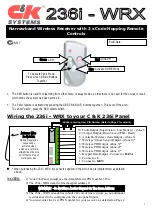
26
Aviat Networks
Chapter 5. Eclipse Edge Commissioning and Troubleshooting
Alarms
Presents an alarm-tree hierarchy for the
selected module.
• Active alarms are opened out to show the
trunk to tree-end path.
• Active alarm points have a colored center.
• Viewed alarms which have been active but
since cleared, will have an up/down arrow
on the right side of their alarm circle.
A Help for Alarm tab supports
context-sensitive alarm help for a selected
(highlighted) alarm. Provides a description of
the alarm, probable cause, recommended
actions, and where applicable additional
information. Online Help must first be loaded
on your Portal PC. Otherwise, view this alarm
information from within the Eclipse Alarms
section of this chapter (for PC-based access),
or from Appendix B
• If a hardware alarm is active,
this should be investigated
before others. Hardware
alarms occur when
communications with a
device fail. Generally
hardware status is only
checked during a power-on,
software reload, or in some
instances, a reconfiguration.
The exceptions are RTC and
ADC hardware alarms, which
are continuously
communicated.
• When multiple alarms are
active, most are likely to be
downstream from the real
fault. For instance, with an
active Demodulator Not
Locked alarm, the
downstream Rx path
warning alarms will also be
active. A Demodulator alarm
may be caused by a loss of
path, (path degradation or a
problem with the remote
Tx), or a fault within the
Demodulator, or its
upstream hardware or
software. As a rule, follow
the guidance provided within
the alarm description for
each alarm.
Screen
Function
Tips
Summary of Contents for ECLIPSE EDGE
Page 1: ...ECLIPSE EDGE Version 5 USER MANUAL 260 668080 001...
Page 2: ......
Page 3: ...Eclipse Edge Microwave Radio System User Manual Software Version 5 0 March 2013...
Page 14: ...16 Aviat Networks INDEX...
Page 18: ......
Page 26: ...8 Aviat Networks Chapter 1 Health and Safety...
Page 272: ...36 Aviat Networks Chapter 3 Eclipse Edge Installation...
Page 273: ......
















































